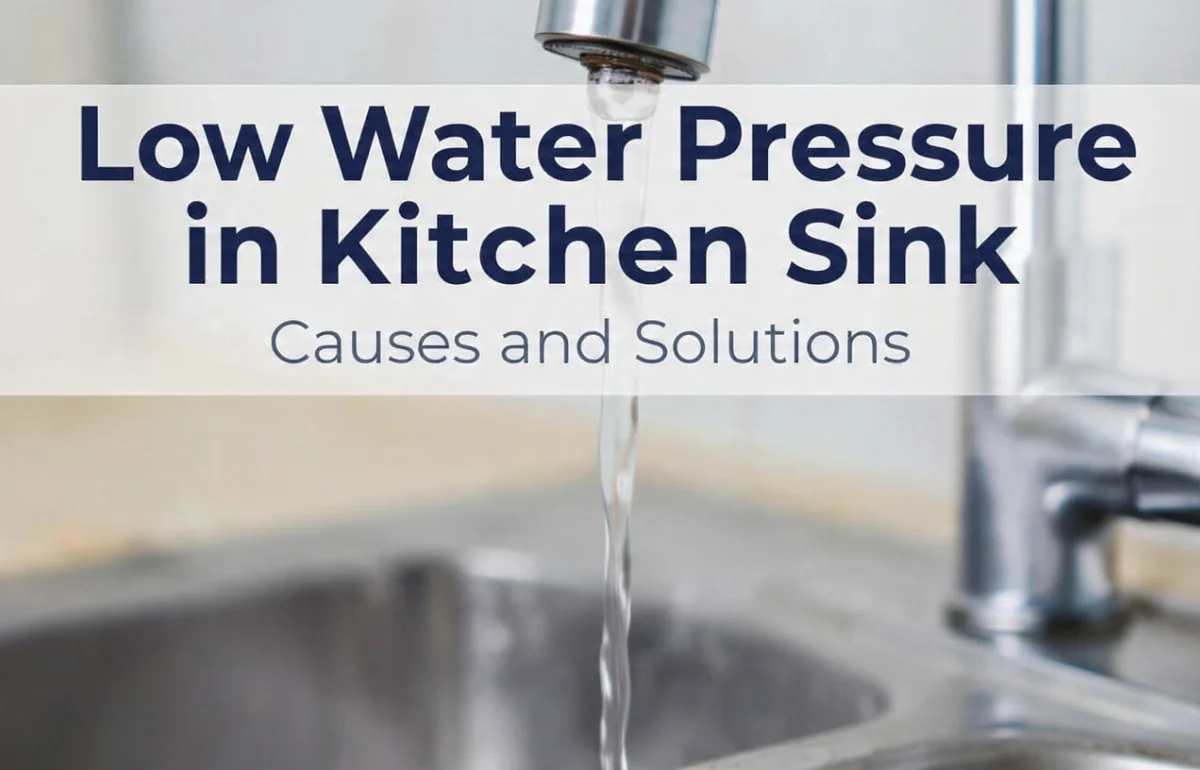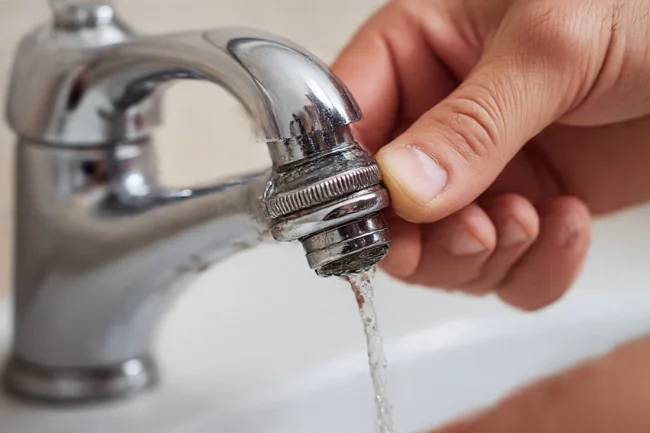
If you’ve noticed low water pressure in kitchen sink, you’re not alone. A weak stream when rinsing dishes or filling a pot is one of the most common plumbing issues homeowners face. The good news? Most causes are minor and easy to fix with a few basic tools.
In this guide, you’ll learn why your kitchen faucet has low pressure, how to diagnose the exact cause, and what to do to restore full water flow — all written in plain English for real people, not plumbers.
Table of Contents
ToggleCommon Reasons for Low Water Pressure in Kitchen Sink
Understanding why water pressure drops is the first step toward solving it. From clogged aerators to corroded pipes, even small issues can lead to big frustration over time.
1- Clogged Aerator Restricting Water Flow
The aerator—that tiny screen at the end of your faucet—is designed to mix air with water for a smooth stream. Over time, minerals like calcium and sediment collect here, blocking the flow. When buildup happens, you’ll notice a weaker, uneven spray. Cleaning or replacing it is usually enough to restore pressure.
2- Dirty or Damaged Faucet Cartridge
The cartridge inside single-handle faucets controls the blend and flow of water. When it gets clogged with mineral deposits or wears out, water struggles to pass through evenly. Replacing it is simple and instantly boosts water flow.
3- Partially Closed Shut-Off Valves
Under your sink, two small valves control the water supply. If one is partially closed—perhaps after a recent plumbing repair—it can restrict pressure. Turning them counterclockwise all the way open often fixes the issue.
4- Kinked or Blocked Supply Line
Flexible supply hoses can twist or kink over time, especially if cleaning supplies or bins press against them. This limits water flow to the faucet. Straighten or replace the line to restore even pressure.
5- Corroded Pipes or Hidden Leaks
Older galvanized pipes slowly corrode inside, reducing diameter and water flow. Hidden leaks behind walls can also reduce pressure while wasting water silently. If you suspect these issues, professional inspection is best.
6- Faulty Pressure Regulator or City Supply Issue
Sometimes, the cause isn’t inside your kitchen at all. A pressure-reducing valve (PRV) gone bad, or municipal water problems, can affect pressure throughout the home. Test pressure at an outdoor spigot to confirm.
How to Diagnose Low Water Pressure in Kitchen Sink (Step-by-Step Guide)

Finding the source of low water pressure in kitchen sink doesn’t require fancy tools — just a bit of observation and patience. The key is to isolate whether the problem lies within the faucet, the supply lines, or the home’s main plumbing.
Start by testing both hot and cold water. If both are weak, the issue is likely near the faucet — such as a clogged aerator or cartridge. If only the hot side is slow, look toward your water heater or the hot supply pipe.
Then, check the aerator for any buildup. Unscrew it and check for grit, lime, or debris. Soak it in white vinegar for half an hour to dissolve buildup, then rinse and reinstall. You’ll be surprised how often this simple step restores full flow.
If pressure remains weak, move under the sink. Turn both shut-off valves completely open. They can get partially closed without you realizing it — especially after cleaning or plumbing work.
Now, disconnect one supply line from the faucet and aim it into a bucket. Set the valve to the on position. If the flow here is strong, the faucet or cartridge is likely the issue. If it’s still weak, the problem lies in the valve, the supply line, or even further upstream.
End by inspecting for leaks. Look for water stains under the cabinet, damp spots on walls, or listen for faint hissing sounds when taps are closed. A hidden leak or corroded line can drain pressure silently.
If all these checks fail, test the home’s overall pressure using a gauge attached to an outdoor hose bib. Optimal readings fall between 40 and 60 psi. Anything below 30 psi usually points to a failing PRV or municipal supply issue.
By taking this methodical approach, you’ll know exactly what you’re dealing with before calling a plumber — and might even save the service call altogether.
Table — Common Causes and Fixes for Low Water Pressure in Kitchen Sink
| Cause | How to Identify | Solution |
|---|---|---|
| Clogged aerator | Weak flow, uneven spray | Remove and clean aerator with vinegar |
| Dirty faucet cartridge | Aerator clear but water still weak | Replace cartridge |
| Partially closed valve | Flow improves when valve opened | Fully open or replace valve |
| Kinked supply line | Weak pressure despite open valve | Straighten or replace hose |
| Corroded pipe or leak | Rusty water, damp cabinet | Repair or repipe affected line |
| Faulty PRV or supply issue | Low pressure throughout house | Adjust or replace PRV, contact water company |
| Hot water side only weak | Cold is fine, hot is not | Flush water heater or check heater line |
How to Fix Low Water Pressure in Kitchen Sink (Complete Solutions)
Once you’ve diagnosed the problem, fixing it becomes a lot easier. The right approach depends on what’s causing the weak flow.
If your aerator is clogged, remove it using a wrench wrapped in cloth to protect the finish. Soak it in vinegar for 20–30 minutes, scrub gently with an old toothbrush, rinse, and reinstall. This step alone fixes low water pressure in kitchen sink for nearly half of homeowners.
For a faulty cartridge, shut off the water supply and remove the faucet handle. Pull out the cartridge with pliers and replace it with a matching one (available at any hardware store). Always check the manufacturer’s instructions for alignment and O-ring placement.
If the shut-off valves are to blame, open them fully or replace corroded ones with new quarter-turn valves. While you’re at it, inspect the supply lines for kinks or internal buildup. Replacing them with stainless-steel braided lines is a durable upgrade.
For leaks or corroded pipes, check under-sink joints and along visible lines. Small leaks can often be sealed temporarily with plumber’s tape, but permanent repair requires a professional to replace the section.
If your home’s pressure is low across all taps, test it with a gauge. When readings fall below 40 psi, adjust or replace the pressure regulator. If that doesn’t help, contact your municipal water supplier to check for local maintenance or restrictions.
In short, fixing low water pressure isn’t complicated. It’s a process of elimination — start with small, inexpensive checks before assuming you need a full plumbing overhaul.
Prevent Future Low Water Pressure in Kitchen Sink

After fixing the issue, a few simple maintenance habits can keep it from returning:
-
Maintain aerators by cleaning them every 3 to 6 months.
-
Perform an annual flush of your water heater to remove mineral deposits.
-
Check shut-off valves yearly for smooth operation.
-
Inspect supply lines for rust or kinks.
-
Install a water softener if you live in a hard water area.
Stopping issues early is easier and cheaper than dealing with damage later. These small efforts help maintain consistent pressure for years.
Knowing When to Bring in a Plumbing Expert
If you’ve tried all the above and still experience low water pressure in kitchen sink, it’s time to call a professional. Licensed plumbers can perform pressure tests, inspect for hidden leaks, and repair or replace pressure regulators safely.
Seek professional help if:
-
Multiple fixtures have weak pressure.
-
Corrosion or rust is clearly visible on plumbing lines.
-
You suspect a main line or PRV issue.
-
There’s a recurring drop in water pressure despite cleaning aerators and valves.
A quick inspection could save you from bigger repairs later, especially if the issue lies beyond your immediate plumbing system.
Restoring Flow — The Bottom Line
Dealing with low water pressure in kitchen sink is annoying, but it’s almost always fixable. Start with the simplest steps — clean the aerator, open valves, check hoses — before assuming the worst.
Fixing water pressure problems restores convenience, saves time, and improves efficiency in everyday kitchen tasks.
Quick tip: If you can spare 10 minutes right now, remove the aerator and soak it in vinegar. It might be the easiest plumbing win you’ll ever have.
FAQs on Low Water Pressure in Kitchen Sink
1. Why is the water pressure low only in my kitchen sink?
Because the issue is usually local, like a clogged aerator or valve problem. If other fixtures are fine, the problem isn’t with your main supply.
2. How can I fix low water pressure in kitchen sink myself?
Clean the aerator, open valves, check hoses, and replace the faucet cartridge if necessary.
3. Can hard water cause poor water flow in kitchen faucet?
Yes, hard water causes mineral buildup that blocks aerators and cartridges over time.
4. Should I replace the faucet if pressure is low?
Only if cleaning and replacing internal parts don’t help. Usually, a new faucet isn’t required.
5. What’s normal water pressure for a kitchen sink?
Most homes maintain water pressure in the 40 to 60 psi range. Anything lower may require adjusting your pressure regulator.
I’m Salman Khayam, the founder and editor of this blog, with 10 years of professional experience in Architecture, Interior Design, Home Improvement, and Real Estate. I provide expert advice and practical tips on a wide range of topics, including Solar Panel installation, Garage Solutions, Moving tips, as well as Cleaning and Pest Control, helping you create functional, stylish, and sustainable spaces that enhance your daily life.
